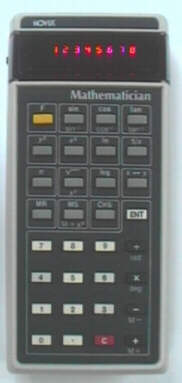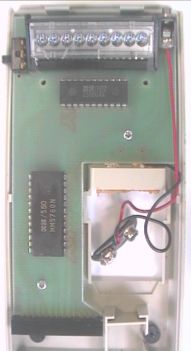

The Novus Mathematician calculator has an eight-digit red LED display and is powered by a 9-volt battery. It has a off-white case with a matte black keyboard label that has silver trim. It has an on/off switch on the left side near the top and a jack for an AC adapter on the top right side. This machine was also known as the National Semiconductor Mathematician and the Novus 4510. Novus was simply another name National Semiconductor used to market their calculators.
The Mathematician is a basic scientific calculator. Like the machines from Hewlett-Packard, the Mathematician uses Reverse-Polish Notation (RPN) for calculation, however, as a low-cost unit it only providesa 3-level stack, and the top register is not copied downward when the stack drops as it is on the HPs. The machine's display is limited to eight digits and does not support either scientific notation or overflow - if the result of a calculation exceeds 99999999 the machine simply displays all it's decimal points and all "0"s. The machine has an automatic power-down mode that lights only the decimal points after a period of inactivity.
The numeric keys and ENT (ENTER) key are white with black letters on the keys, while the four arithmetic keys are black with white letters on the keys. The "F" function prefix key is yellow, with gray function keys that have their primary function on the keyboard label above the key and their secondary function below the key. The "C" (CLEAR) key is red. This key clears the "X" register and drops the stack one level, you have to press it 3 times to completely clear the stack.
The scientific functions provided by the calculator include: sin, cos, tan (and their inverses), y to the x, e to the x, ln, 1/x, square root and log. A pi key is provided. X exchange Y, CHS (sign change), and radians or degrees selection functions are provided. The calculator has one memory and provides MS (MEMORY STORE), MR (MEMORY RECALL), M + x squared, M+, and M- functions. The scientific functions are not particularly fast in this calculator. The trig and log functions take over a half-second and the y to the x function takes over two seconds. The display flashes during the calculation. The accuracy doesn't seem to be particularly impressive, a calculation of 2 to the 16th power gives 65535.82 as an answer, which indicates to me that there aren't any extra digits used internally for calculations.

The internal construction of the machine is quite simple, as shown in the photo above. Removing two screws on the back allows the top part of the calculator to separate from the bottom. The top part contains only the keyboard and the red plastic display bezel. A flexible printed circuit connects the keyboard to a 13-pin edge connector mounted on the calculators Printed Circuit Board (PCB)
The PCB contains the few components of the calculator. The machine was obviously designed with low cost in mind. The PCB is fiberglass with copper tracks on the bottom side only. The components are all mounted on the top. In addition to the keyboard connector, the only other components are two ICs, the on/off switch, the 9-volt battery connector, the AC power adapter jack, and a tilted, edge-card-type connector that holds the plug-in, 9-digit LED display module. The main calculator IC is a National MM5760N, which is in a 28-pin plastic package. The other IC appears to be the LED driver, and is a National DS8864N 22-pin device. There are no resistors or capacitors in this machine - everything is handled by the ICs. By the date codes on the ICs, it appears that my particular machine was manufactured in early 1976.